Making Flare Gas Useful

Wärtsilä has developed the GasReformer, a product which converts associated gas, which is often flared, into usable fuel for its dual-fuel engines. When producing oil, associated gas is also released from the deposits. In many places this gas is commonly burnt off in gas flares, a waste of energy and a pollutant of the atmosphere. In addition to useful methane, this gas consists of heavier hydrocarbons including ethane, propane and butane. The composition of the gas typically also vary during the production phase of the oil field.
ABS Notation for Well Test Ops Vessels, MODUs
ABS has issued a series of notations in support of critical well testing activities being undertaken by energy operators worldwide to determine the commercial nature of their reservoirs. The importance of well testing to determine the nature of reservoirs has become even more critical lately as ultra deepwater exploration with pre-salt fields now has operators exploring in water depths surpassing 10,000 feet. Not only is the depth a challenge but also the complexity of the reservoir structures. A vessel or mobile offshore drilling unit (MODU) with the equipment and capabilities to engage in well testing, either short-term or extended, is key in gathering onsite data to determine the size and quantity of the hydrocarbon potential.
Feature: Maritime Mission Impossible Accomplished
By Capt. In 2002 the globally operated Korean engineering and construction firm Daewoo E & C Co., Ltd., secured a project order from Shell Petroleum Development Company (SPDC) of Nigeria to construct a gas gathering plant on two concrete barges, to be positioned in the Awoba Creek near the Sambriero River. This gas gathering plant would be connected with a pipeline to the Cawthorne Channel Integrated Project (CCIP). The CCIP is a gas-gathering project, which is a big step forward in contributing to the "flare out" target date in 2008 of the numerous gas flares, as mandated by the Nigerian Government. On December 19 and 22, 2003, respectively, the Process Barge and the Control Barge were safely put on the underwater foundation in Awoba, and first gas is expected by Spring 2004.





